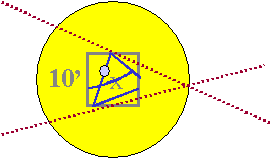(Week 50, 2002, 09 Dec. - 15 Dec.)
In the display above (click to enlarge), the solar X-ray fluence seen by RESIK (black points) is plotted atop GOES red line. Only periods with good spectral measurements are indicated. The total number of good spectral measurements is given in the title line.
| New mode: | '3rd
order reflections' (ORD3) is used as stand-by mode. 3rd order spectra observations are indicated on the main catalogue page http://www.cbk.pan.wroc.pl/2002.htm (cf. green boxes).
|
| Calibrations made: |
No calibrations made |
| ADS Settings: |
|
|
|
|
| (ORD1) HV: Det. A - 1450 V, Det. B - 1389 V. | (ORD3) HV: Det. A - 1398 V, Det. B - 1325 V. | ||||||
|
Channel |
l Band |
ADS |
Channel |
l Band |
ADS |
||
| #1 | #2 | 3.37 - 3.88 Å | 35 - 85 | #1 | #2 | 1.16 - 1.29 Å | 110 - 230 |
| #2 | #0 | 3.82 - 4.33 Å | 70 - 120 | #2 | #0 | 1.27 - 1.44 Å | 110 - 230 |
| #3 | #3 | 4.31 - 4.89 Å | 55 - 110 | #3 | #3 | 1.44 - 1.63 Å | 110 - 230 |
| #4 | #1 | 4.96 - 6.09 Å | 90 - 160 | #4 | #1 | 1.65 - 2.03 Å | 140 - 230 |
|
software indexes |
|
software indexes |
|||||
|
spectroscopic notation (papers) |
spectroscopic notation (papers) |
||||||
Data gaps due to missing telemetry: ~ 6.5 h.
RESIK & Diogeness on the Payload
and Coronas-F pointing
This week, we show the location of both Polish spectrometers within the CORONAS-F satellite payload. This picture will help in understanding the relationship between the S/C attitude and positions of strong emission lines observed on the spectra. In the picture below, we show the photograph of the payload in the final stage of pre-flight
preparations in
Plesetsk (picture from official experiment web
page: http://coronas.izmiran.rssi.ru/F/spacecraft).
A more detailed scheme of the placement of the instruments on the payload is shown below. The II is the main reference (X) axis of the satellite. For description of the other instruments seen on the payload, visit http://coronas.izmiran.rssi.ru/F/instruments.
The dispersion planes of both RESIK and Diogeness are coaligned, normal to the satellite main axis. The uncertainty of coalignment is given by the accuracy of mechanics and mounting and is expected to be better than 5
arcmin. Within each instrument, the dispersion planes of each individual crystal are coaligned to much better accuracy of ~30 arcsec. For RESIK, the internal coalignment took place at MSSL in 2000, and has been made by Dr. Charlie Brown from NRL with the use of special co-alignment tools and the autocollimator. Below is the photograph of crystals of one RESIK section being co-aligned.
The CORONAS-F S/C is not fully three-axis stabilised. Its pointing is however very stable in time, much better than the technical specifications for the system required. Below is a scheme, how the S/C pointing is
achieved:

The Z-axis (small circle) pointing towards the optical Sun centre is drifting (see blue line in a diagram) within 10 arcmin box. The roll may assume any position in respect to the solar coordinates, however the rate of change is very slow (~1deg/day).
We have no way to determine the actual roll angle from RESIK or Diogeness data alone. However, the star sensors constitute a part of the SPIRIT instrument designed by FIAN group http://coronas.izmiran.rssi.ru/F/SRT/.
Thanks to the generosity of dr.dr. I.A. Zhitnik and S. Kuzin, (kuzin@mail1.lebedev.ru), we can access a very accurate attitude CORONAS-F data base. In the plots below , we show the history of CORONAS_F roll angle, as well as the offset (slightly smoothed) of the Z axis from the centre of the solar disk. It is seen that the roll angle variations are small, less than 1 degree/day, and the normal to the payload axis is usually within less than 5 arcmin from the solar disk centre. Knowledge of the S/C attitude is vital for determinations of the accurate wavelength scale for the spectra recorded during flares, provided the flare location on the solar disk is known. This subject will be elaborated in one of the forthcoming Notes.
Report prepared by: Janusz Sylwester js@cbk.pan.wroc.pl
The report presented has been done in "real time" and so it may
contain jargon, blunders, or trivialities. We do not have also an English native
speaker in our Wroclaw group! We would be happy to discuss problems mentioned
above in more details if necessary.
RESIK data are in the open public domain and can be requested from: http://surfwww.mssl.ucl.ac.uk/surf/data_request.html.
Previous RESIK_weekly notes are in the
archive:
http://www.cbk.pan.wroc.pl/resik_archive.htm
Page made on 20 December 2002 by: Jarek Bakala jb@cbk.pan.wroc.pl